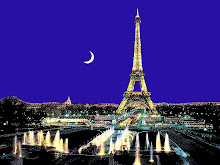Something not so nice
Labels :
Guillotine,
Rue Croix-Faubain
Isabella and some others asked me if I had nothing less attractive to show from France and Paris. Here is a try:
These pictures are from a today just ordinary street in Paris, called Rue Croix-Faubin, in the 11th arrondissement. There is however something surprising about this street, as you can find five rather big granite stones.
 These stones supported the guillotine which was installed here for each – public – execution between the years 1851 and 1899. Just behind these stones you could then find the entrance to the Grande Roquette prison where the major criminals by that time were kept. The prison was demolished in 1900 and the place for executions changed. In the meantime, some 200 executions may have taken place.
These stones supported the guillotine which was installed here for each – public – execution between the years 1851 and 1899. Just behind these stones you could then find the entrance to the Grande Roquette prison where the major criminals by that time were kept. The prison was demolished in 1900 and the place for executions changed. In the meantime, some 200 executions may have taken place.

 Executions were public in France until 1937. The last execution took place in 1977 and capital punishment was officially - and I would add fortunately – at last abolished in 1981.
Executions were public in France until 1937. The last execution took place in 1977 and capital punishment was officially - and I would add fortunately – at last abolished in 1981.
These pictures are from a today just ordinary street in Paris, called Rue Croix-Faubin, in the 11th arrondissement. There is however something surprising about this street, as you can find five rather big granite stones.
 These stones supported the guillotine which was installed here for each – public – execution between the years 1851 and 1899. Just behind these stones you could then find the entrance to the Grande Roquette prison where the major criminals by that time were kept. The prison was demolished in 1900 and the place for executions changed. In the meantime, some 200 executions may have taken place.
These stones supported the guillotine which was installed here for each – public – execution between the years 1851 and 1899. Just behind these stones you could then find the entrance to the Grande Roquette prison where the major criminals by that time were kept. The prison was demolished in 1900 and the place for executions changed. In the meantime, some 200 executions may have taken place.
 Executions were public in France until 1937. The last execution took place in 1977 and capital punishment was officially - and I would add fortunately – at last abolished in 1981.
Executions were public in France until 1937. The last execution took place in 1977 and capital punishment was officially - and I would add fortunately – at last abolished in 1981. 













33 comments:
You succeeded in finding something that is unattractive.
There were public executions during the same time period here in Arkansas, famous ones attended by hundreds out for a picnic party, in Fort Smith, ordered by the Hanging Judge Isaac Parker.
Sadly, the U.S. is still barbarically executing people and calling it "justice".
Thank you in advance.. I'm in debt to you...
additional info, they'll spend few nites in beziers b4 coming back to paris (8/9 till 11/9-noon) and will be staying @ backpackers hostel called 3 ducks hostel..
thanks again..:P
It seems that all countries have part of their history which is shameful, obviously barbaric. In the 21st century it seems that advances have been made in many areas, but we are not really totally "human" in all respects. So much sadness...still.
bravo pour ce travail de recherche, je suis impressionné. Enfin tout finit bien grace à mr badinter.
cheer for this research task, I am impressed. Finally all finishes thanks to Mr. badinter well.
And again, an expert of a history is writing :) And how much more we can see, when we know about things, thanks to you for all those knowledges!
Somebody has said, that the history books could label the war books,if we think about it, it may be true, wars inside and outside boundaries change a world of humans and now also conseqenses of a technology. What people can read after two hundred years about our times, what do you think ?
Have a good Wednesday, Peter!
wow ... they might not look that interesting but what a history.
Shit! I missed that one when I lived in Paris! And I even had a friend living just a block away from that street (just checked on Google maps). We used to take the rue de la Roquette up to Père Lachaise with her children. That wasn't far away. I wonder if my friend knew about the guillotine having been almost next to where she lived (lives?). Lea, if you see this, please contact me!
Some further comments linked to the above comments:
You would never find these stones unless you had read about them. They are very discrete and actually partly under the parked cars. I'm not an historian at all; I read about these stones in a book and as I was close to the place yesterday, I thought I should look for them. I learn every day and try to transmit. hpy: The pedestrian crossing you see is actually the one you use when walking up the rue de la Roquette towards the the Père Lachaise cemetery, so I guess you walked on them without paying attention, which I would also have done if I had not incidentally read about them.
Streets are paved with, not gold, but sorrow.
Good post, Peter.
Pour repondre à ta question, à Evry-Courcouronnes, une tres grande partie des sculptures sont offertes par des entreprises via l'association "mécénat d'entreprise EPREVRY Évry".
Interesting post, including photos and research, Peter. The idea that so-called civilised societies still carry out executions, and there has even been talk in some quarters about televising them, disgusts me. You've only got to look at the statistics for miscarriages of justice, never mind the dubious justifications such as "deterrent". I wonder how many people put their heads in that machine knowing themselves that they were innocent. I remember a quote from a US convictee shortly before being dispatched - "Boy, this is sure going to teach me a lesson.."
This is a very interesting post. The idea the stones were reused is interesting. They could have been tossed away somewhere. I don't know why they were used in the street? That might be a more important question. I am sure there are stories about their use in old newspaper accounts. Our country still kills people. The state does it or kills criminals who were sentenced to die. People kill each other here in all kinds of ways. Not just by guns and knives. One woman drove her car into a pond while her children were strapped in their seats. She is in prison. I would have been more satisfied had she been put to death. But that is just me.
Thanks for sharing this with us. I think there would be many more like these unattractive ones. These are the history we all should know about and most preferably preserve.
Have you seen those metal marks on Champs-Elysees ??
Jag har alltid varit emot dödstraffet,var ung när Caryl Chessman efter 14 år i dödscellen dödades mot sitt nekande. Över 80 personer har nu i USA visat sig genom genprov varit oskyldiga men de är döda genom avrättning.Frankrike har genom historien varit ett land med många avrättade.Hur kan man stå och se på när mna låter bilan falla? Jag skulle aldrig kunna detta!
abraham:
Although I can somehow understand you reaction concerning this mother and also could understand that someone in a sudden and uncontrolled anger kills (could also be partly avoided if no weapons available), I can not understand by the state coldly planned "murders"; already as a "philosophy", but also for all the "mistakes" that take place.
The stones were supposed to go to a museum, but were not wanted, so it was decided to leave them there (actually, they were put back).
cuckoo:
I will revert about the Champs Elysées.
hogrelius:
Hàller med om allt!
That is very interesting, Peter. I always learn something reading your blog! Well done!
Je sais comment tu as pris ces photos, mais il faudra m'expliquer comment tu as mis ces ronds rouges.Il ne faisait pas bon vivre à cette époque (surtout pendant la révolution)On dit que les jeux de Rome étaient cruels, mais les exécutions publiques n'étaient pas mieux!!!
As always, I am impressed.
PETER!!!
The moment I saw the picture & read the first sentence, I knew what that stone was!!!I wonder how that became possible!!!
My head is reeling!
WOW! so many posts & so many wonderful pictures!
It is so much variety & beuty in color here. That is why I LOVE your blog Peter! :)
& a dream come true!!! to be able to meet blogger friends! You all seem so happy! I feel so glad for you. I wish I could meet my blogger friends...
J'aime bien cette façon de lire la ville comme un palimpseste, comme si l'histoire transparaissait à la surface des choses.
I admit - this is a legitimate attempt on your part to address my comment and very well executed ;-)
Speaking of which - you mentioned that the executions were public until 1937. Did you mean, they took place inside the prison, or outside, with the public present?
To me it might look unattractive but after this post I think it is so rich in culture & history....I will take a closer look if I walk on this street again.
For someone coming from the first European country to abolish death penalty it was reassuring to read your last remark!
Pas beau mais drôlement intéressant...
Où tu vas chercher tout ça, toi ?
gmg:
I was not aware that Portugal was first! Good and good to know!
cergie:
J'ai quelques livres sur Paris reçus en cadeaux. Il est évident qu'on ne trouve guère ces pierres par hasard, mais il y a aussi un panneau sur le lieu qui explique l'histoire. On trouve de plus en plus ces panneaux au long des rues. Tant mieux.
quite ghastly...any strange happenings to date? such as headless bodies flagging for a cab middle of the night..lol...pls comment
I made a mistake here! The gate of the prison was in the other direction! I should go back for a new photo!
What mistake did you make? It was as you show it on the photo, and on the picture (exécution of Doré and Berland, 1891) which you found on my website dedicated to La Roquette.(http://laroquette.site.voila.fr).
You're probably mistaking it with the gate of the other prison, la Petite Roquette, which stood right opposite the Grande Roquette.
Yes, there were two prisons indeed which you seem not to be aware of.
Yes, I have realised my mistake and will make a new post! Did I steal the picture from you? I'm really sorry; normally I pay attention to only take from Wikipedia, Wikimedia or similar sites. I will visit your site before trying to make a new one!
Let's say, that in certain way I was correct without knowing that there were two prisons, so my picture is correct, but I would anyhow like to make a new post.
I have added a new post in my new blog, January 19, 2008.
Very useful material, much thanks for the article.
Post a Comment